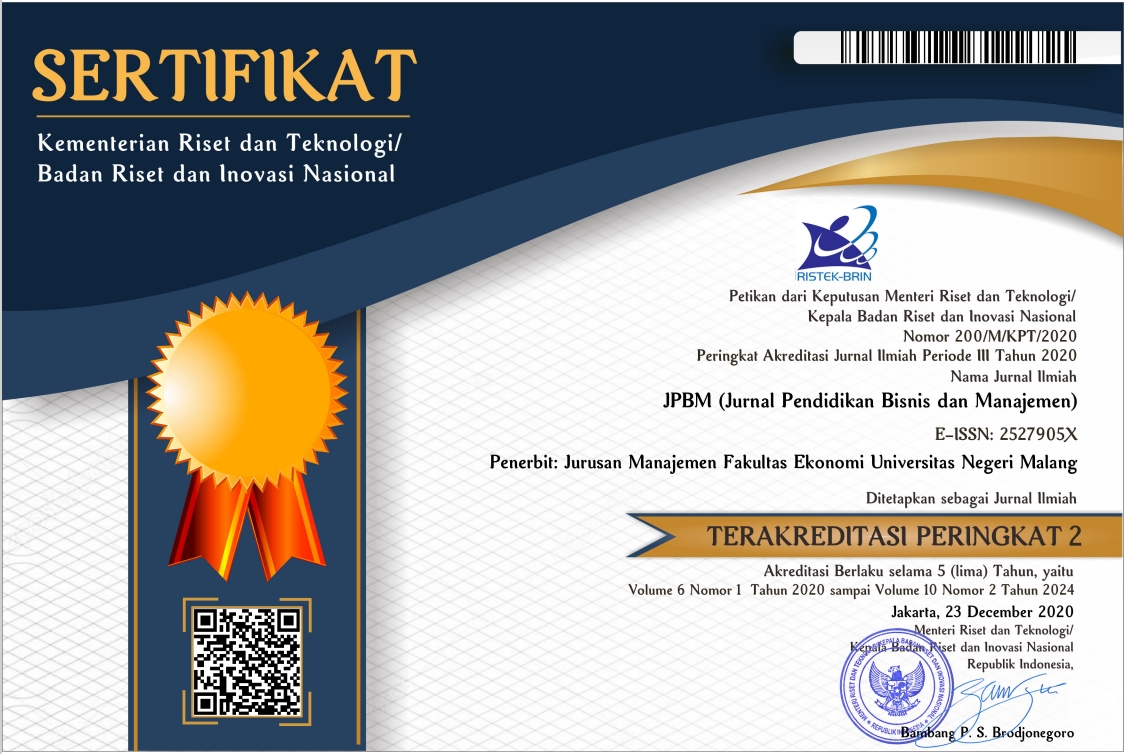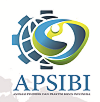Improving Student’s Independence and Learning Outcomes Through Website-based Instructional Media
Abstract
The use of digital learning is a critical component of developing technology information and communication skills. The purpose of this study aims to develop a web-based Petty Cash Management Information System for financial administration courses to increase student autonomy and learning outcomes. This type of research and development employed a modified version of Borg and Gall’s Research and Development model. The study’s subjects included media and material experts serving as expert validators, six students serving as user validators, and large group test subjects. Quantitative data were gathered through the calculation of scores on validation questionnaires, independence questionnaires, and psychomotor test scores; qualitative data were gathered through interviews, criticisms, and suggestions. The independent sample t-test and descriptive qualitative analysis are used to analyze the data. The validation and trial results indicate that the learning media is appropriate for its designation, learning objectives, and ease of use and that it can be applied to support learning and improve student learning outcomes. The resulting product is unique in that it supports automation, complies with requirements, and features a distinct user interface for lecturers and students.
Keywords: Financial Administration, Instructional Media, Learning Independence
Full Text:
PDFReferences
Ana, & Achdiani, Y. (2015). Penerapan self regulated learning berbasis internet untuk meningkatkan kemandirian belajar mahasiswa. INVOTEC, XI(1), 15–22.
Astuti, B. (2019). Profil kemandirian belajar mahasiswa bimbingan dan konseling. Jurnal Penelitian Ilmu Pendidikan, 12(1), 63–74. https://doi.org/10.21831/jpipfip.v12i1.24327
Baran, E. (2014). A review of research on mobile learning in teacher education. Journal of Educational Technology & Society, 17(4), 17–32.
Benedict, L., & Pence, H. E. (2012). Teaching chemistry using student-created videos and photo blogs accessed with smartphones and two-dimensional barcodes, 1, 10–14. https://doi.org/10.1021/ed2005399
Bernacki, M. L., Greene, J. A., & Crompton, H. (2020). Mobile technology, learning, and achievement: Advances in understanding and measuring the role of mobile technology in education. Contemporary Educational Psychology, 6 (November 2019). https://doi.org/10.1016/j.cedpsych.2019.101827
Bernhardt, P. E. (2015). 21st Century learning: Professional development in practice 21st century learning : Professional Development in Practice. 20(1), 1–19.
Budiantoh, H., & Ranu, M. E. (2015). Pengembangan media pembelajaran interaktif menggunakan macromedia flash pada mata pelajaran korespondensi di smkn 1 Surabaya. Jurnal Pendidikan Administrasi Perkantoran (JPAP), 3(1), 1–15.
Bungsu, T. K., Vilardi, M., Akbar, P., & Bernard, M. (2020). Pengaruh Kemandirian belajar terhadap hasil belajar Matematika Di SMKN 1 Cihampelas. Journal On Education, 1(2), 382–389. https://doi.org/10.46918/karst.v3i1.538
Dabbagh, N., & Kitsantas, A. (2012). Personal learning environments, social media, and self-regulated learning: A natural formula for connecting formal and informal learning. Internet and Higher Education, 15(1), 3–8. https://doi.org/10.1016/j.iheduc.2011.06.002
Darussalam, A. (2015). Pengembangan media pembelajaran berbasis web interaktif (Blog) untuk meningkatkan motivasi belajar pada mata pelajaran pemasaran online sub kompetensi dasar merancang website (Studi pada Siswa Kelas X Tata Niaga SMK Negeri 2 Nganjuk). Jurnal Pendidikan Tata Niaga, 3(2), 1–7.
Efriyanti, L., & Annas, F. (2020). Aplikasi mobile learning sebagai sarana pembelajaran Abad 21 pada era revolusi industri 4.0. Jurnal Educative: Journal of Educational Studies, 5(1).
Fahmi, S., Priwantoro, S. W., Cahdriyana, R. A., Hendroanto, A., Rohmah, S. N., & Nisa, L. C. (2019). Interactive learning media using Kvisoft Flipbook Maker for Mathematics Learning. Journal of Physics: Conference Series, 1188(1). https://doi.org/10.1088/1742-6596/1188/1/012075
Fausih, M., & T, D. (2015). Pengembangan media E-Modul Mata pelajaran produktif pokok bahasan “Instalasi Jaringan LAN ( Local Area Network )” Untuk Siswa Kelas XI Jurusan Teknik Komputer Jaringan Di SMK Negeri 1 Labang Bangkalan Madura. Jurnal Nasional Pendidikan Teknik Informatika, 1(1), 1–9.
Hatta, M., Tianah, A., & Amroni. (2015). Dana kas kecil metode imprest fund system. Digit, 5(1), 89–102.
Hidayati, K., & Listyani, E. (2010). Pengembangan instrumen kemandirian belajar mahasiswa. Jurnal Penelitian dan Evaluasi Pendidikan, 14(1), 84–100.
Ihsan, M. A., Liza, T. R., Setiawan, D., & Asmaidi. (2019). Web-based learning media application. Mantik Penusa, 3(2), 51–54. https://doi.org/Terakreditasi DIKTI No.SK 21/E/KPT/2018
Januarisman, E., & Ghufron, A. (2016). Pengembangan media pembelajaran berbasis web mata pelajaran ilmu pengetahuan alam untuk Siswa Kelas VII. Jurnal Inovasi Teknologi Pendidikan, 3(2), 166. https://doi.org/10.21831/jitp.v3i2.8019
Kivunja, C. (2014). Do You want your students to be job-ready with 21st century skills? change pedagogies: A pedagogical paradigm shift from vygotskyian social constructivism to critical thinking, problem solving and siemens’ digital connectivism. International Journal of Higher Education, 3(3), 81–91. https://doi.org/10.5430/ijhe.v3n3p81
Li, J., Sheng, J., Chen, Y., Ke, L., Yao, N., Miao, Z., … Wang, Q. (2020). A web-based learning environment of remote sensing experimental class with python. The International Archives of the Photogrammetry, Remote Sensing and Spatial Information Sciences, Volume XLIII-B5-2020, 2020 XXIV ISPRS Congress, XLIII, 57–62. https://doi.org/https://doi.org/10.5194/isprs-archives-XLIII-B5-2020-57-2020
West, D. (2013). Mobile learning : Transforming education, engaging student, and improving outcames. Center for Technology Innovation at Brookings, (September).
Manohar, T., Dashputra, A., & Suresh, C. (2015). Students’ Perception about teaching learning media in didactic lectures. Jeths, 2(III), 103–107.
Pratomo, A., & Irawan, A. (2015). Pengembangan media pembelajaran interaktif berbasis web menggunakan metode hannafin dan peck. Aircraft Engineering and Aerospace Technology, 1(1), 14–28. https://doi.org/10.1108/eb034372
Priyambodo, E., Wiyarsi, A., & Sari, R. . L. P. (2012). Pengaruh media pembelajaran interaktif berbasis web terhadap motivasi belajar mahasiswa. Kependidikan, 42(2), 99–109.
Sari, A., & Setiawan, A. (2018). The development of internet-based economic learning media using moodle approach. International Journal of Active Learning, 3(2), 100–109.
Rohdiani, F., & Rakhmawati, L. (2017). Pengembangan pembelajaran berbasis web pada mata pelajaran dasar elektronika di SMK Negeri 3 Jombang. Jurnal Pendidikan Teknik Elektro, 6(1), 105–110.
Rosita, I., & Nur, D. (2016). Meningkatkan kemampuan berpikir kreatif matematis dan kemandirian belajar siswa dengan menggunakan model pembelajaran brain based learning. Jurnal Pendidikan Unsika, 4(1), 26–41.
Santos, O. C., Boticario, J. G., & Pérez-Marín, D. (2014). Extending web-based educational systems with personalised support through User Centred Designed recommendations along the e-learning life cycle. Science of Computer Programming, 88, 92–109. https://doi.org/10.1016/j.scico.2013.12.004
Sari, H. V., & Suswanto, H. (2017). Pengembangan media pembelajaran berbasis web untuk mengukur hasil belajar siswa pada mata pelajaran komputer jaringan dasar program keahlian teknik komputer dan jaringan. Jurnal Pendidikan: Teori, Penelitian, dan Pengembangan, 2(7), 1008–1016. Diambil dari http://journal.um.ac.id/index.php/jptpp/article/view/9734/4593
Seufert, T. (2018). The interplay between self-regulation in learning and cognitive load. Educational Research Review, 24, 116–129. https://doi.org/10.1016/j.edurev.2018.03.004
Suprianto, S., Arhas, S. H., & Salam, R. (2018). Pengaruh media pembelajaran dan pengelolaan kelas terhadap prestasi belajar siswa di SMK Negeri Kecamatan Tanete Riattang, Kabupaten Bone. Jurnal Ad’ministrare: Jurnal Pemikiran Ilmiah dan Pendidikan Administrasi Perkantoran, 5(2), 137–146. Diambil dari http://ojs.unm.ac.id/index.php/administrare/indeks
Susanto, H., & Akmal, H. (2019). Media pembelajaran sejarah era teknologi informasi : konsep dasar, prinsip aplikatif, dan perancangannya. In Media Pembelajaran.
Uno, H. B., & Ma’ruf, A. R. K. (2016). Pengembangan media pembelajaran IPS berbasis website untuk siswa kelas VII Madrasah Tsanawiyah Negeri. Teknologi Pendidikan, 18(3), 169–185.
Warsita, B. (2018). Mobile learning sebagai model pembelajaran yang efektif dan inovatif. Jurnal Teknodik, 14(1), 062. https://doi.org/10.32550/teknodik.v14i1.452
Widiyaningtyas, T., & Widiatmoko, A. (2014). Media pembelajaran berbasis web pada mata pelajaran Kimia. Jurnal Teknologi, 21, 47–51.
Wiriyanti, M., Syarif, S., Ahmad, M., Prihartini, S. D., & Wahy-, I. S. (2020). Pengaruh media pembelajaran berbasis WEB terhadap peningkatan keterampilan Praktikum Asuhan Kala II Persalinan Mahasiswa DIII Kebidanan. Keperawatan Muhammadiyah.
Wulandari, B., & Surjono, H. D. (2013). Pengaruh problem-based learning terhadap hasil belajar ditinjau dari motivasi belajar PLC di SMK. Jurnal Pendidikan Vokasi, 3(2), 178–191. https://doi.org/10.21831/jpv.v3i2.1600
Xiao, Y., & Yang, M. (2019). Formative assessment and self-regulated learning: How formative assessment supports students’ self-regulation in English language learning. System, 81, 39–49. https://doi.org/10.1016/j.system.2019.01.004
Zheng, L. (2016). The effectiveness of self-regulated learning scaffolds on academic performance in computer-based learning environments: a meta-analysis. Asia Pacific Education Review, 17(2), 187–202. https://doi.org/10.1007/s12564-016-9426-9
Zhu, J. (2010). The development and applied research of E-learning resources. IC4E 2010 - 2010 International Conference on e-Education, e-Business, e-Management and e-Learning, 564–566. https://doi.org/10.1109/IC4E.2010.101
Zubaidah, S. (2016). Keterampilan abad ke-21 : keterampilan yang diajarkan melalui pembelajaran. (2), 1–17.
Refbacks
- There are currently no refbacks.
JPBM (Jurnal Pendidikan dan Bisnis Manajemen) is licensed under a Creative Commons Attribution-NonCommercial-ShareAlike 4.0 International License.
JPBM (Jurnal Pendidikan dan Bisnis Manajemen) is abstracted and indexed in :
















